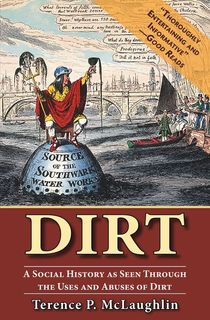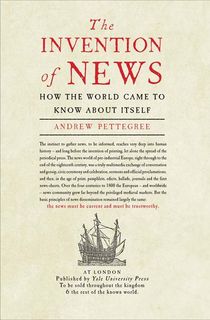As the name suggests, a microhistory book delves deep into the story of a specific object or theme. By focusing on a single subject in such detail, it allows the author to shed a unique light on its impact on wider historical events and its significance to particular places and cultures.
Microhistory books now cover such a diverse range of topics that there really is something to suit everyone. Packed full of interesting detail and little-known facts, the following 11 microhistory books cover everything from salt and coal to air conditioning and public hygiene, and prove that there is a fascinating story to tell behind some of the even seemingly most mundane aspects of everyday life.

Dirt
In Dirt, Terence McLaughlin looks at human history from a unique perspective, investigating how attitudes toward cleanliness and hygiene have changed over the centuries. Along the way, he uncovers plenty of intriguing facts on topics ranging from personal hygiene and public sanitation to the pollution resulting from industrialization. Dirt was published over 50 years ago, but McLaughlin’s insights into the part played by humankind in shaping our own environment are just as relevant today.

Cool
In his “all-encompassing guidebook to the history of air conditioning” (San Francisco Book Review), Salvatore Basile chronicles the development of this everyday appliance that many of us now take for granted. Cool reveals just how many failed attempts there were to come up with an adequate cooling device before the moment in 1901 when a young engineer named Willis Carrier successfully developed an “Apparatus for Treating Air”. Basile does not end his detailed account there, but also provides fascinating insight into just how long it took thereafter for air conditioning to become widely accepted and its impact on the world today.

Timekeepers
Each chapter of Simon Garfield’s entertaining Timekeepers deals with a different topic inspired by mankind’s obsession with timekeeping. The author’s enthusiasm for his subject and trademark dry sense of humor are evident throughout this exceptionally well-researched book, in which he covers everything from a scheme to decimalize the clock devised during the French Revolution to the way in which time is manipulated by the modern film and music industries. The Telegraph described Garfield’s approach as “scholarly but jokey, with a magpie’s appetite for glittering trivia”.

A Secret History of Brands
In A Secret History of Brands, pop culture historian Matt MacNabb has come up with engrossing insights into the origins of some of today’s most famous global brands, including Coca Cola, Ford, Kellogg’s, Chanel and Adidas. His extensively researched account sheds light on the lengths to which some big businesses will go in the name of publicity, as well as uncovering some dark secrets, including instances of personal tragedy, drug abuse and disturbingly close ties to Nazi Germany.

The Invention of News
The timeframe for Andrew Pettegree’s absorbing The Invention of News has been well chosen, beginning just before the invention of the printing press in the early 1400s and ending four centuries later at the point at which newspapers became the main source of news. That is because Pettegree’s “judicious and well written” account (BBC History Magazine) aims to show the way in which information was gathered and disseminated across Europe during the pre-newspaper era through the likes of proclamations, pamphlets, posters and even just good old gossip. In so doing, the author also reveals how news gradually became the concern of everyone rather than just the political and social elite.

The Geometry of Love
Christian churches were originally planned with the specific purpose of conveying particular religious messages and themes through the way in which they were designed, as was the artwork which hung on the walls. Today, the meaning behind much of this architectural symbolism has been lost, which makes Margaret Visser’s The Geometry of Love a particularly interesting read. Guiding her reader through the layout and design of an early Christian church dedicated to Saint Agnes, near Rome, the author uncovers the hidden secrets of this glorious old building. The result is “an engaging piece of cultural and religious history” (Washington Post Book World).

Salt
Salt is such a familiar household item that it is all too easy to overlook the important role it has played throughout history. Mark Kurlansky “finds the world in a grain of salt” (New York Times Book Review) in his book on this surprisingly intriguing topic, which combines social, political, religious and culinary history. Amongst many interesting facts, Kurlansky reveals how this commodity was once considered so valuable that it served as currency and, with reference to Gandhi’s famous salt march of 1930, even served as a catalyst for a protest movement.

Coal: A Human History
Environmental analyst Barbara Freese traces the fascinating history of our relationship with coal in this New York Times Notable Book. In this topical and thought-provoking account, the author combines the story of how this deceptively simple natural commodity has transformed human society by powering industrial growth with an investigation into the more negative aspects of humanity’s dependence on coal, particularly in relation to the environment. The New Scientist described Coal as “an absorbing book that never loses its grip”.

Blood
Awarded a 1998 Los Angeles Times book award, Douglas Starr’s epic history of blood was praised by the judges for its “significant contribution to the history of medicine and technology”. Divided into three main sections, Starr illustrates how humanity’s attitudes towards blood have changed over time. Once viewed as an object of religious veneration, blood later became the subject of scientific curiosity. This led to significant medical breakthroughs but also an increasing number of ethical dilemmas. Starr’s engaging microhistory is vividly written and full of interesting detail, meaning it will appeal to scientists, historians and non-academics alike.

Longitude
The search for an effective method of determining longitude at sea involved many of the world’s best scientists over several centuries, but only in the 18th century did the unknown John Harrison, an English clockmaker, come up with a solution to the problem. Dava Sobel’s Longitude tells the fascinating story of Harrison’s groundbreaking invention, the marine chronometer, which transformed navigational methods and thus made an invaluable contribution to safety at sea. Harrison spent many years perfecting his invention and Sobel brilliantly brings to life the many trials and tribulations he encountered along the way including “political intrigues, personal feuds and financial skullduggery” (Daily Mail).

A History of the World in 6 Glasses
Tom Standage’s innovative A History of the World in 6 Glasses offers a unique perspective on the story of Western civilization through six drinks. The Los Angeles Times remarked: “There aren’t many books this entertaining that also provide a cogent crash course in ancient, classical and modern history”.
Using each drink to represent a pivotal moment in human history, Standage begins with beer’s importance to the Ancient Egyptians. This ingenious microhistory then takes in the ancient Greeks and Romans (wine), the colonial period (spirits), the age of reason (coffee) and the British empire (tea). Standage ends with Coca-Cola, which he links to the rise in American dominance on the world stage and the growth of capitalism.
This post is sponsored by Open Road Media. Thank you for supporting our partners, who make it possible for The Archive to continue publishing the history stories you love.
Feature image: Annie Spratt / Unsplash





